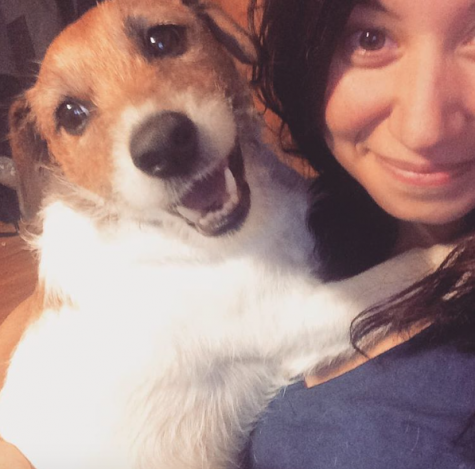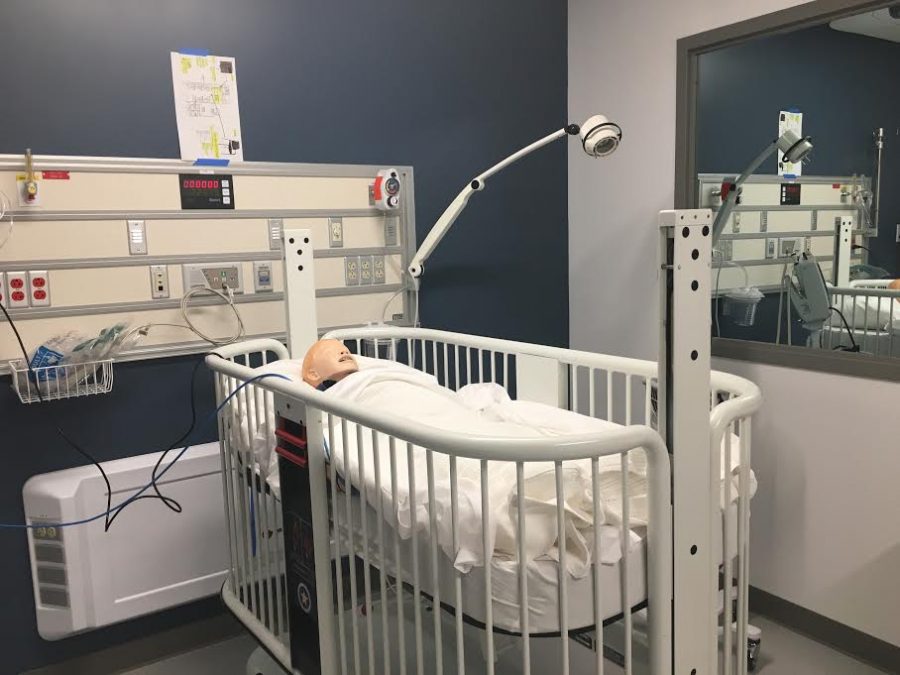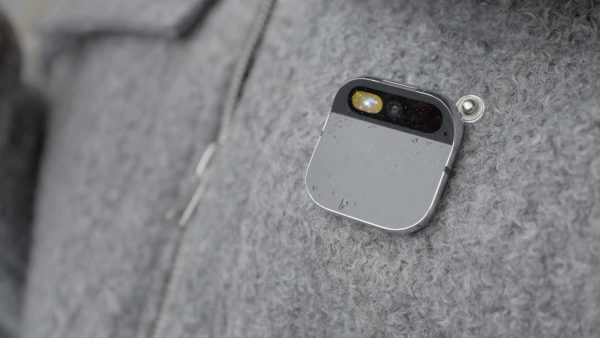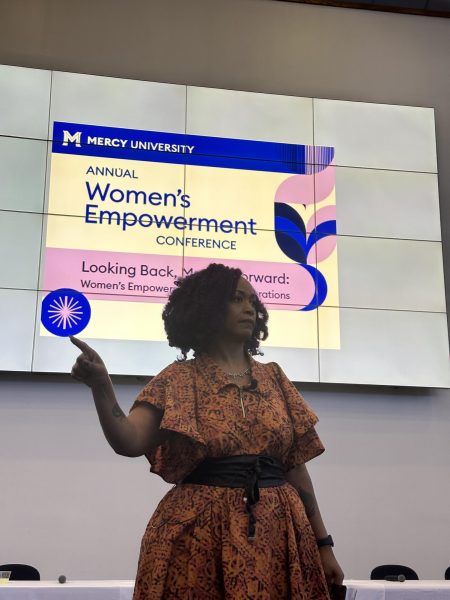Nursing Unveils The New Skills Lab To Students
When Mercy opened its doors for the Spring 2017 semester, the nursing program opened its brand new $5 million Skills Lab in Main Hall to simulation patients.
The Skills Lab is equipped with controls for O2, air, suction plus IVs and IM injections, as well as beds – everything one would see when entering a hospital.
One of the longest walls of the lab, its sectioned into four rooms that are each Simulation Labs.
In each room, there’s a simulated patient monitor, two cameras, a speaker, microphone, and a two way mirror. The first room has a pediatric patient; the second holds another; the third has a pregnant mother and two babies, while the fourth holds an infectious disease patient.
While they’re all diverse, different races and genders, these patients are mannequins that imitate a real person.
Joya Ransom, a graduate student completing her practicum in the lab this semester, says, “Simulation, by definition, is the process of imitating the real world systems.”
Each mannequin is set up into three different fidelity levels: low, medium and high, which show the degree of realism.
“Low fidelity,” Ransom said, “are parts of the body such as the throat if students are working on a tracheostomy.”
She explained that medium fidelity allows a user to see the control panel on the outside of the body. “It’s somewhat real, but at the same time, you know it’s a computer.”
With regard to high fidelity, Ransom said, “One doesn’t see the control panel. It’s built inside the leg.”
The other side of the two way mirror is the place where everything comes to life.
“The brand new lab with mannequins is a great place for students to learn before entering the real world,” Ransom says.
“Students are able to practice in a safe environment. They’re free to make errors,” Ransom said. “In a real hospital, dealing with a patient, errors could be very critical.”
Patrice Sobecki, the Clinical Placement Advisor in the School of Health and Natural Sciences, added, “They can hear lung and heart sounds, which are essential for them to be accurate when they’re in a real life situation.”
A monitor in each room acts as a cardiovascular monitor, which is something seen and used in a hospital setting everyday.
All sessions that students have with the simulated patients are recorded. Every movement and word is recorded to help them better themselves for the future, as they go into the Debriefing Room afterwards.
“When students go back to the Debriefing Room, they look over what they did,” Ransom said. “They check to see what mistakes they made, if they made any, and if so, how they can correct it next time.”
The lab is in no way encouraging students to make mistakes, but encouraging that if they do, they can always look back to see what they did wrong to correct their errors.
“The philosophy of simulation is not to show what you did wrong. It’s to focus on what might you could have done better to have a better outcome.”
On the other side of the two way mirror is the control room, which is where everything comes to life. A simulator technician can interact with students, where they control actions such as heart rate, breathing, and reaction to medications.
“If a student nurse has given too much medication, the heart rate will speed up,” Ransom said. “It’s using nursing theory and relating it to nursing practice.”
“All within a safe environment,” Sobecki added.
Though they may be computer operated, they do everything that a real human does such as breathe, communicate, dilate eyes and simulate all body fluids such as blood, urine, stool, tears and sweat.
Putting it into perspective, Sobecki said, “When we’re in a dark room, our pupils get bigger. Once the lights are turned on, our pupils turn small.”
“Their eyes do the same.”
**
None of the mannequins have names that stick because each scenario is always different.
“We have a library that has 300 scenarios,” Sobecki began to say. “None of the mannequins has a name because one scenario could be for male or female.”
“You can change the sex of the mannequin, or have it set to angel mode, so there is no gender.”
The simulation could have frostbite, amputation, a vasectomy, and could possibly need stitches. The mannequin in the third room is a high-fidelity, where it gives birth.
“We have what’s called an RIF chip, which is what the students put up to the mannequin so they can respond to medications or oxygen,” Ransom said.
If the mannequin is having difficulty breathing, it might mean it needs medication because there’s too much fluid in the lungs, Sobecki gives an example.
“The students have to look at what the doctors orders are and at the monitors,” she began to say. “If it’s oxygen that they need, the students put the chip near the nose and the scenario will change once the vital signs do.”
Each scenario has a different problem to solve. There is a beauty to this, Ransom says, as it gives students the opportunity to be in a situation they may not have the chance to see, or may not be involved in of as a student nurse in a hospital.
“If someone went into cardiac arrest, a student is never going to be a part of it,” Ransom said. “The purpose is to resuscitate the patient.”
“But first they need to know how to do that, and this is where they are given that opportunity to practice it,” Sobecki joined in.
In the third room is the pregnant mannequin. Ransom jokes saying the mannequin gives birth, “with placenta, too.”
“It sounds funky, but many things can go wrong during childbirth,” she said.
“We want students to be prepared, just in case,” Sobecki added, as she pointed out the two baby mannequins in the room.
One is a CPR baby, where students can hear the heart sound, while the other is a high fidelity mannequin who cries.
“When babies are born, their vital signs are unstable, and it’s a nurse’s job to bring it to stable,” Ransom said.
The fourth room is the isolation room, where the Skills Lab also tries to be as realistic as a hospital setting.
“There are different diseases in the world right now, and giving students the opportunity to experience what isolation is and what cautions to take are extremely vital,” Sobecki said.
In describing what goes on in the room, Ransom explains when dealing with infectious disease patients, such as someone with tuberculosis,it’s important that nurses know how to dress, to put the gown and gloves on, as well as how to take them off.
“People don’t realize how important it is.”
To say the nursing program has become extremely high tech with its new $5 million Skills Lab is an understatement. The program is trying to teach its students everything that is vital to the real world and become accustomed to diversity with patients and different scenarios so that real patients are in the right hands.
“We do most of our learning through mistakes,” Ransom said with a laugh. “Students will definitely learn that here.”

Kayla Simas is a Journalism major at Mercy College. She's from the forgotten borough of New York - Staten Island. She's an avid coffee drinker and enjoys...













